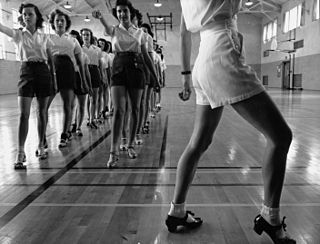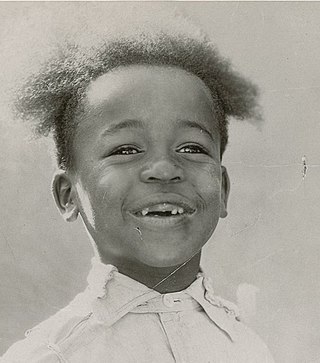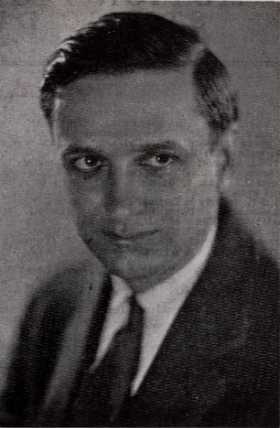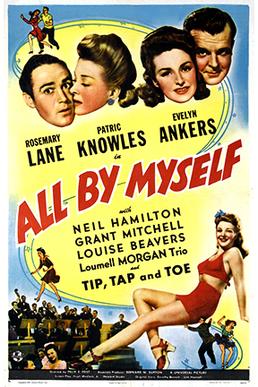Related Research Articles

Tap dance is a form of dance characterized by using the sounds of tap shoes striking the floor as a form of percussion and is often accompanied by music. Tap dancing can also be done using an a cappella method, in which no musical accompaniment is provided, and dancers create their own "music" through the sounds of their taps.

Ginger Rogers was an American actress, dancer and singer during the Golden Age of Hollywood. She won an Academy Award for Best Actress for her starring role in Kitty Foyle (1940), and performed during the 1930s in RKO's musical films with Fred Astaire. Her career continued on stage, radio and television throughout much of the 20th century.

Fred Astaire was an American dancer, actor, singer, choreographer and presenter. He is widely regarded as the "greatest popular-music dancer of all time". He received numerous accolades including an Honorary Academy Award, three Primetime Emmy Awards, a BAFTA Award, two Golden Globe Awards, and a Grammy Award. He was honored with the Film Society of Lincoln Center tribute in 1973, the Kennedy Center Honors in 1978, and AFI Life Achievement Award in 1980. He was inducted into the Hollywood Walk of Fame in 1960, American Theatre Hall of Fame in 1972, and the Television Hall of Fame in 1989.

Raymond Wallace Bolger was an American actor, dancer, singer, vaudevillian, and stage performer who started his movie career in the silent-film era.

Gregory Oliver Hines was an American dancer, actor, choreographer, and singer. He is one of the most celebrated tap dancers of all time. As an actor, he is best known for Wolfen (1981), The Cotton Club (1984), White Nights (1985), Running Scared (1986), The Gregory Hines Show (1997–1998), playing Ben on Will & Grace (1999–2000), and for voicing Big Bill on the Nick Jr. Channel animated children's television program Little Bill (1999–2004).

Eleanor Torrey Powell was an American dancer and actress. Best remembered for her tap dance numbers in musical films in the 1930s and 1940s, she was one of Metro-Goldwyn-Mayer's top dancing stars during the Golden Age of Hollywood. Powell appeared in vaudeville, on Broadway, and most prominently, in a series of movie musical vehicles tailored especially to showcase her dance talents, including Born to Dance (1936), Broadway Melody of 1938 (1937), Rosalie (1937), and Broadway Melody of 1940 (1940). She retired from films in the mid-1940s and then began hosting a Christian children's TV show, but she resurfaced for the occasional specialty dance scene in films such as Thousands Cheer and eventually headlined a successful nightclub act in Las Vegas. She died from cancer at 69. Powell is known as one of the most versatile and powerful female dancers of the Hollywood studio era.

William Washington Beaudine was an American film director. He was one of Hollywood's most prolific directors, turning out films in remarkable numbers and in a wide variety of genres.

Bill Robinson, nicknamed Bojangles, was an American tap dancer, actor, and singer, the best known and the most highly paid African-American entertainer in the United States during the first half of the 20th century. His long career mirrored changes in American entertainment tastes and technology. His career began in the age of minstrel shows and moved to vaudeville, Broadway theatre, the recording industry, Hollywood films, radio, and television.

Eugene W. Jackson II was an American child actor who was a regular of the Our Gang short series during the silent Pathé era.

Edwin Eugene Lockhart was a Canadian-American character actor, playwright, singer and lyricist. He became an American citizen in 1939.

"That Old Black Magic" is a 1942 popular song written by Harold Arlen (music), with the lyrics by Johnny Mercer. They wrote it for the 1942 film Star Spangled Rhythm, when it was sung by Johnny Johnston and danced by Vera Zorina. The song was nominated for the Academy Award for Best Original Song in 1943 but lost out to "You'll Never Know".

John William Sublett, known by his stage name John W. Bubbles, was an American tap dancer, vaudevillian, movie actor, and television performer. He performed in the duo "Buck and Bubbles", who were the first black artists to appear on television. He is known as the father of "rhythm tap."

Francis Healey Albertson was an American actor who had supporting roles in films such as It's a Wonderful Life (1946) and Psycho (1960).

This is a comprehensive guide to over one hundred and fifty of Fred Astaire's solo and partnered dances compiled from his thirty-one Hollywood musical comedy films produced between 1933 and 1968, his four television specials and his television appearances on The Hollywood Palace and Bob Hope Presents the Chrysler Theatre which cover the period from 1958 to 1968. Further information on the dance routines may be obtained, where available, by clicking on the film links.
Nicholas "Slug" Brodszky was a composer of popular songs for the theatre and for films.

Greta Gynt was a Norwegian dancer and actress. She is remembered for her starring roles in the British classic films The Dark Eyes of London, Mr. Emmanuel, Take My Life, Dear Murderer and The Ringer.

Ethel Owen was an American actress with a lengthy career on stage as well as radio and television. In her early sixties, during the mid-1950s, she had a memorable recurring TV role on The Honeymooners, playing Mrs. Gibson, Ralph Kramden's sharp-tongued, interfering mother-in-law.

Theresa Harris was an American television and film actress, singer and dancer.

Howard J. Green was an American screenwriter who worked in film and television. He was the first president of the Screen Writers Guild and a founder of the subsequent Writers Guild of America, West.

All by Myself is a 1943 American comedy film directed by Felix E. Feist and written by Hugh Wedlock Jr. and Howard Snyder. The film stars Rosemary Lane, Evelyn Ankers, Patric Knowles, Neil Hamilton, Grant Mitchell and Louise Beavers. The film was released on June 11, 1943, by Universal Pictures.
References
- 1 2 3 Tip, Tap, and Toe.
{{cite book}}:|work=ignored (help) - ↑ StreetSwing Dance History Archives
- ↑ "Tap Dance". Encyclopedia Britannica. Retrieved June 13, 2019.
- 1 2 Tip, Tap & Toe, Internet Movie Database (IMDB)
- Marshall and Jean Stearns, Jazz Dance: The Story of American Vernacular Dance (1968) p. 272
- Larry Billman, Film Choreographers and Stage Directors: an Illustrated Biographic Encyclopedia, 1893–1995 (1995) pp. 66, 146, 389, 508-509
- Rusty Frank, TAP! The Greatest Tap Dance Stars and Their Stories 1900-1955 (1995), pp. 65, 229, 295, films: 303-315